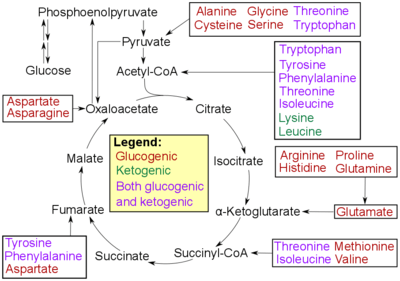Ketogenic amino acid
A ketogenic amino acid is an amino acid that can be degraded directly into acetyl-CoA, which is the precursor of ketone bodies and "myelin, especially during early development, when brain myelin synthesis is extremely high” according to the National institute of Health.[1] This is in contrast to the glucogenic amino acids, which are converted into glucose. Ketogenic amino acids are unable to be converted to glucose as both carbon atoms in the ketone body are ultimately degraded to carbon dioxide in the citric acid cycle.

In humans, two amino acids are exclusively ketogenic:
(remembered as all the "L" amino acids)
In humans, five amino acids are both ketogenic and glucogenic:
(remembered by the useful mnemonic "PITTT" or "FITTT", and includes all the aromatic amino acids)
- Phenylalanine (abbreviated Phe or F, in contrast to Proline which is Pro or P, based on their respective pronunciations)
- Isoleucine
- Threonine (some authors don't recognize it as a ketogenic amino acid)
- Tryptophan
- Tyrosine
In humans, the remaining thirteen amino acids are exclusively glucogenic (i.e. are not ketogenic).[2]
Studies
Ketogenic amino acids serve important roles in the human body, leading to the study of ketogenic amino acid rich (KAAR) diets as possible treatment for non-alcoholic fatty liver disease (NAFLD) and diabetes.[3] Dietary studies of fatty liver disease in mice show that decreasing the intake of ketogenic amino acids lysine and threonine may induce hepatic steatosis, a major cause of non-alcoholic fatty liver disease.[4] Lysine in particular has been shown to serve an important role in the metabolic pathway for insulin via activation of the rapamycin complex 1 (mTORC1) and protein S6 kinase 1 (S6K1) for which over-activation leads to insulin resistance.[5] Further studies illustrate that ketogenic amino acid rich diets may aid in decreasing obesity and insulin resistance, but their usage remains disputed.[3]
See also
- Glucogenic amino acid
- List of standard amino acids
- Ketogenesis
- Metabolism
References
- "Ketogenic diet: Amino Acids, Substrates, and Ketones | How it All Works". November 19, 2014. Archived from the original on April 28, 2019. Retrieved April 28, 2019.
- Berg J, Tymoczko J, Stryer L (2015-04-08). "Protein Turnover and Amino Acid Catabolism". Biochemistry (eighth ed.). ISBN 978-1-4641-2610-9. Archived from the original on 2007-06-30.
- Noguchi Y, Nishikata N, Shikata N, Kimura Y, Aleman JO, Young JD, Koyama N, Kelleher JK, Takahashi M, Stephanopoulos G (August 2010). "Ketogenic essential amino acids modulate lipid synthetic pathways and prevent hepatic steatosis in mice". PLOS ONE. 5 (8): e12057. Bibcode:2010PLoSO...512057N. doi:10.1371/journal.pone.0012057. PMC 2919399. PMID 20706589.
- Singal SA, Hazan SJ, Sydenstricker VP, Littlejohn JM (February 1953). "The production of fatty livers in rats on threonine-and lysine-deficient diets". The Journal of Biological Chemistry. 200 (2): 867–74. PMID 13034849.
- Hinault C, Mothe-Satney I, Gautier N, Lawrence JC, Van Obberghen E (December 2004). "Amino acids and leucine allow insulin activation of the PKB/mTOR pathway in normal adipocytes treated with wortmannin and in adipocytes from db/db mice". FASEB Journal. 18 (15): 1894–6. doi:10.1096/fj.03-1409fje. PMID 15479767.
External links
- Amino acid metabolism
- Amino acid metabolism

